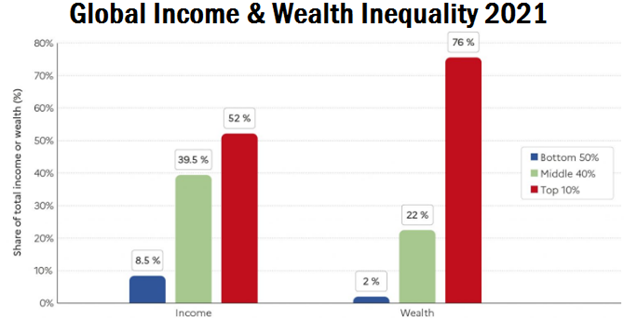World Inequality Report 2022
- 10 Dec 2021
“World Inequality Report 2022” was recently released by France-based World Inequality Lab.

Key Findings (Global)
We are still there where we were at the 20th Century
- Global inequalities today are as much as they were at the peak of Western imperialism in the early 20th century.
- The share of income presently captured by the poorest half of the world’s population is about half of what it was in 1820, before the great divergence between Western countries and their colonies.
Poorest Half owns 2% of Global Wealth
- The poorest half of the global population “barely owns any wealth” possessing just 2 per cent of the total, whereas the richest 10 per cent of the global population own 76 per cent of all wealth, it states.
Most Unequal Region
- The Middle East and North Africa (MENA) are the most unequal regions in the world.
Region with Lowest Inequality
- Europe has the lowest inequality levels. In Europe, the top 10 per cent income share is around 36 per cent, whereas in MENA it is 58 per cent.
Whole of the Wealth is in Private Hands
- There is a huge gap between the net wealth of governments and net wealth of the private sector.
- In the last 40 years, countries have become significantly richer, but their governments have become significantly poorer.
- The share of wealth held by public actors is close to zero or negative in rich countries, which means that the whole of the wealth is in private hands.
India-specific Findings
India stands out as a “poor and very unequal country with affluent elite”.
Why India as a ‘very unequal country'
- The top 10 per cent holds 57 per cent of total national income.
- The top 1 per cent holds 22 per cent of total national income.
- The bottom 50 per cent share has gone down to 13 per cent of national income.
- So, India stands out as a poor and very unequal country with affluent elite.
| MPI & Poor in India
|
Gender Inequalities: The female labour income share is equal to 18% which is significantly lower than the average in Asia and this value is one of the lowest in the world.
What the Report Suggests
- The report has suggested levying a modest progressive wealth tax on multimillionaires.
- It says that given the large volume of wealth concentration, modest progressive taxes can generate significant revenues for governments that can be reinvested in education, health and the ecological transition.




